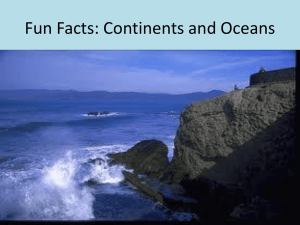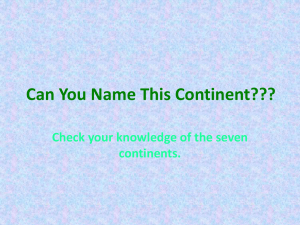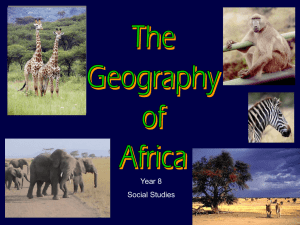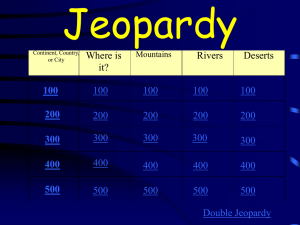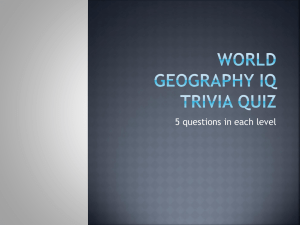Continents and Oceans
advertisement
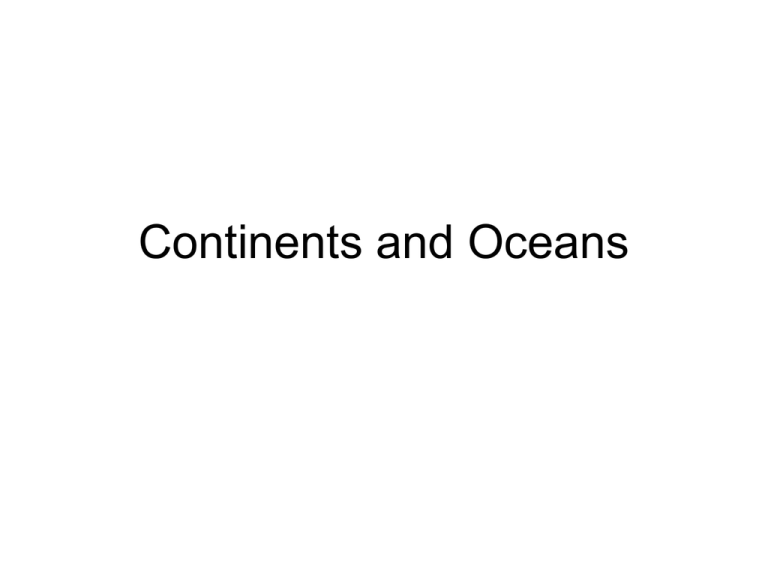
Continents and Oceans NORTH AMERICA GEOGRAPHY FACTS: • North America, the planet’s 3rd largest continent, includes (23) countries and dozens of possessions and territories. It contains all Caribbean and Central America countries, Bermuda, Canada, Mexico, the United States of America, as well as Greenland - the world’s largest island. Positioned in the planet's northern and western hemispheres, it's bordered in the north by the Arctic Ocean, in the east by the Atlantic Ocean, in the southeast by the Caribbean Sea and Gulf of Mexico, and in the west by the Pacific Ocean. • • • Percent of Earth's Land: 16.5% Highest Point: Mt McKinley in Alaska, 20,322ft (6,194m) Lowest Point: Death Valley in California, -282 ft (-86m) below sea level South America Geography Facts: • South America, the planet's 4th largest continent, includes (12) independent countries and (3) major territories; the Falkland Islands, Galapagos Islands and French Guiana. The continent contains the world's highest waterfall, Angel Falls in Venezuela; the largest river (by volume), the Amazon River; the longest mountain range, the Andes, and the driest place on earth, the Atacama Desert in Chile. In addition, it includes the largest rainforest, the Amazon Rainforest; the highest capital city, La Paz, Bolivia; the highest commercially navigable lake in the world, Lake Titicaca; and, excluding research stations in Antarctica, the world's southernmost permanently inhabited community, Puerto Toro, Chile. Europe Geography Facts: • Europe is the planet's 6th largest continent AND includes 47 countries and assorted dependencies, islands and territories. Europe's recognized surface area covers about 9,938,000 sq km (3,837,083 sq mi) or 2% of the Earth's surface, and about6.8% of its land area. In exacting geographic definitions, Europe is really not a continent, but part of the peninsula of Eurasia which includes all of Europe and Asia. However, it's still widely referred to as an individual continent. The European continent, bordered by numerous bodies of water, is separated from Asia by Russia's Ural Mountains and by the Caspian and Black Seas. It is separated from Africa by the Mediterranean Sea. • • • • • • Ukraine is Europe's largest country The Vatican is Europe's smallest country Germany is Europe's largest country by population The Vatican is Europe's smallest country by population Europe's highest point is Mt. Elbrus in Russia Europe's lowest point is the Caspian Sea bordering Russia Asia Geography Facts: • As the largest and most populous continent in the world with just over 3.8 billion people, Asia is composed of a wide variety of ethnic groups, cultures, environments, economics, historical ties, and governmental systems. • In the east, Asia is bordered by the Pacific Ocean, and an almost endless stretch of bays and seas. Geographically the continent makes up 8.7% of the Earth's total surface area, and 29.5% of its land area. The Arctic Ocean and a handful of seas front the northern border, while the Bering Sea separates Asia from North America. In the southwest the Red Sea and isthmus of Suez separate the continent from Africa. In the west, Asia is bordered by Europe, the eastern coastline of the Mediterranean Sea, as well by the Sea of Marmara, the Bosporus Strait, the Black Sea and the Caspian Sea. The Indian Ocean fronts most of Asia's southern borders, along with a series of bays, gulfs and seas, as well as extensive chains of both inhabited and uninhabited islands. Eurasia Africa Geography Facts: • Africa, the planet's 2nd largest continent and the second most-populous continent (after Asia) includes (54) individual countries, and Western Sahara, a member state of the African Union whose statehood is disputed by Morocco. Note that South Sudan is the continent's newest country. With a 2011 population of 1,032,532,974, it accounts for just over 14% of the world's human population. It also contains the Nile River system, the world's longest, and the massive Sahara Desert, the world's largest. Africa is surrounded by the Mediterranean Sea to the north, both the Suez Canal and the Red Sea along the Sinai Peninsula to the northeast, the Indian Ocean to the east and southeast, and the Atlantic Ocean to the west. • • Nile River System: The Nile is a northflowing river considered the longest river in the world at 6,650 km (4,130 mi) long. Sahara Desert: It's the world's hottest desert, the third largest desert after Antarctica and the Arctic, and almost as large as China. Covering almost one-third of the continent, the Sahara is the largest desert in the world at approximately 3,500,000 sq. miles (9,065,000 sq. km) in total size. Australia/Oceania Geography Facts: • Australia, the planet's smallest continent, is without doubt one of the most diverse and fascinating areas on the planet. A large percentage of geography experts now consider the long-established continent of Australia to be more accurately defined as Australia/Oceania. Collectively it then combines all of Australia, New Zealand, Papua New Guinea, as well as the thousands of coral atolls and volcanic islands of the South Pacific Ocean, including the Melanesia and Polynesia groups. Oceania also includes Micronesia, a widely scattered group of islands that run along the northern and southern edges of the Equator. Antarctica Geography Facts: • Size: 13,209,000 sq km, 5,100,021 sq miles (varies due to changing ice shelves) • Percent of Earth's Land: 8.9% • Status: Antarctica, almost 98% solid ice, was finally considered a continent in 1840, and not just a group of isolated islands. Today it has active territorial claims submitted by Argentina, Australia, Chile, France, New Zealand, Norway and the United Kingdom. (Many of these claims are not recognized by some countries and remain in a constant disputed status) • Climate Antarctica is the coldest and windiest spot on the planet. In fact, the lowest temperature ever recorded on Earth was recorded in Antarctica (-129.3ºF) and the mean winter temperatures range from -40º to -94ºF. Winds are commonly measured at up to 200 miles per hour. Map Activity • Creating a Flat Map Projection! What you need: -Continent Handout -Blue Paper -Scissors -Glue Stick Directions: 1. Cut out the continents and label them • 2. Place them correctly on the blue paper-(double check in the textbook,your partner or teacher before gluing) 3. Glue continents in correct position 4. Label the oceans 5 .If you have extra time, you may color the continents • Group Work Expectations • Sharing Materials
